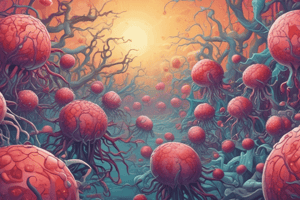Podcast
Questions and Answers
What is a common way for microbes to gain access to the body?
What is a common way for microbes to gain access to the body?
- Through the digestive system
- Through the respiratory system
- Through openings in the skin, such as hair follicles and sweat gland ducts (correct)
- Through the circulatory system
Which of the following can establish a parenteral route of entry?
Which of the following can establish a parenteral route of entry?
- Punctures, injections, or wounds (correct)
- Inhalation of contaminated air
- Natural shedding of skin cells
- Consumption of contaminated food
Why is the portal of entry important for microbes?
Why is the portal of entry important for microbes?
- Because it allows microbes to avoid the host's immune system
- Because it affects the type of disease that will occur (correct)
- Because it determines the number of microbes that can enter
- Because it determines the severity of the disease
Which of the following mucous membranes is most susceptible to microbial penetration due to its delicacy?
Which of the following mucous membranes is most susceptible to microbial penetration due to its delicacy?
What determines the likelihood of disease when microbes enter the body?
What determines the likelihood of disease when microbes enter the body?
What is the primary mechanism by which microorganisms bypass host defenses in the skin?
What is the primary mechanism by which microorganisms bypass host defenses in the skin?
How can microbes infect the skin?
How can microbes infect the skin?
Which of the following routes of infection is also known as the parenteral route?
Which of the following routes of infection is also known as the parenteral route?
What is required for microbes to cause disease?
What is required for microbes to cause disease?
Which portal of entry is specific to sexually transmitted infections?
Which portal of entry is specific to sexually transmitted infections?
What is the primary mechanism by which microorganisms damage host cells?
What is the primary mechanism by which microorganisms damage host cells?
Which of the following is a characteristic of mucous membranes that makes them prone to microbial penetration?
Which of the following is a characteristic of mucous membranes that makes them prone to microbial penetration?
What is the primary function of the M protein produced by Streptococcus pyogenes?
What is the primary function of the M protein produced by Streptococcus pyogenes?
Which of the following mechanisms is used by some pathogens to obtain free iron from the host?
Which of the following mechanisms is used by some pathogens to obtain free iron from the host?
What is the primary function of capsules in bacterial pathogens?
What is the primary function of capsules in bacterial pathogens?
Which of the following enzymes is involved in the breakdown of fibrin and facilitation of bacterial movement?
Which of the following enzymes is involved in the breakdown of fibrin and facilitation of bacterial movement?
What is the primary function of mycolic acid in Mycobacterium tuberculosis?
What is the primary function of mycolic acid in Mycobacterium tuberculosis?
Which of the following mechanisms is used by some pathogens to damage host cells?
Which of the following mechanisms is used by some pathogens to damage host cells?
Study Notes
Portals of Entry
- Microorganisms can enter the body through: mucous membranes, skin, and direct deposition beneath the skin or membranes (parenteral route)
- Mucous membranes are a common portal of entry, including: respiratory tract, gastrointestinal tract, genitourinary tract, and conjunctiva
- Skin is the largest organ in terms of surface area and weight, and can be penetrated by microorganisms
Protecting Against the Host's Defenses
- Bacterial capsules can resist phagocytosis, a process by which certain cells engulf and destroy microorganisms
- Examples of bacteria with capsules include: Streptococcus pneumoniae
- Cell wall components can also contribute to virulence, such as:
- Streptococcus pyogenes producing M protein, which mediates attachment and resists phagocytosis
- Mycobacterium tuberculosis producing waxy lipid (mycolic acid), which resists digestion by phagocytes
Enzymes and Toxins
- Some bacteria produce extracellular enzymes (exoenzymes) that aid in virulence
- Examples of enzymes include:
- Coagulases, which coagulate fibrinogen into fibrin to protect the bacterium from phagocytosis
- Kinases, which break down fibrin and allow bacteria to move further
How Pathogens Damage Host Cells
- Pathogens can damage host cells by:
- Using the host's nutrients, such as iron, by producing siderophores
- Directly damaging host cells
- Producing toxins
Number of Invading Microbes
- The likelihood of disease increases as the number of pathogens increases
- A small number of microbes may be overcome by the host's defenses, but a large number can set the stage for disease
Studying That Suits You
Use AI to generate personalized quizzes and flashcards to suit your learning preferences.
Description
This quiz covers the mechanisms of bacterial pathogenesis, including the role of capsules in resisting host defenses and cell wall components that contribute to virulence.




